Resource Management Interface Specs
Release v. 3.0.4
18 JUL 2005
Scott Jackson
Brett Bode
David Jackson
Kevin Walker
Status of This Memo
This is a specification defining an XML message format used between Scalable Systems Software components. It is intended that this specification will continue to evolve as these interfaces are implemented and thoroughly tested by time and experience.
Abstract
This document is a specification describing a message format for the interaction of resource management and accounting software components developed as part of the Scalable Systems Software Center. The SSSRMAP Message Format defines a request-response syntax supporting both functional and object-oriented messages. The protocol is specified in XML Schema Definition. The message elements defined in this specification are intended to be framed within the Envelope and Body elements defined in the SSSRMAP Wire Protocol specification document.
Table of Contents
1.0 Introduction
A major objective of the Scalable Systems Software [SSS] Center is to create a scalable and modular infrastructure for resource management and accounting on terascale clusters including resource scheduling, grid-scheduling, node daemon support, comprehensive usage accounting and user interfaces emphasizing portability to terascale vendor operating systems. Existing resource management and accounting components feature disparate APIs (Application Programming Interfaces) requiring various forms of application coding to interact with other components.
This document proposes a common message format expressed in an XML request-response syntax to be considered as the foundation of a standard for communications between and among resource management and accounting software components. In this document this standard is expressed in two levels of generality. The features of the core SSSRMAP protocol common to all resource management and accounting components in general are described in the main body of this document. The aspects of the syntax specific to individual components are described in component-specific binding documents.
2.0 Conventions Used in This Document
2.1 Keywords
The keywords “MUST”, “MUST NOT”, “REQUIIRED”, “SHALL”, “SHALL NOT”, “SHOULD”, “RECOMMENDED”, “MAY”, and “OPTIONAL” in this document are to be interpreted as described in RFC2119 [RFC2119].
2.2 XML Case Conventions
In order to enforce a consistent capitalization and naming convention across all SSSRMAP specifications “Upper Camel Case” (UCC) and “Lower Camel Case” (LCC) Capitalization styles shall be used. UCC style capitalizes the first character of each word and compounds the name. LCC style capitalizes the first character of each word except the first word. [XML_CONV][FED_XML]
- SSSRMAP XML Schema and XML instance documents SHALL use the following conventions:
- Element names SHALL be in UCC convention (example: <UpperCamelCaseElement/>.
- Attribute names SHALL be in LCC convention (example: <UpperCamelCaseElement lowerCamelCaseAttribute=”Whatever”/>.
- General rules for all names are:
- Acronyms SHOULD be avoided, but in cases where they are used, the capitalization SHALL remain (example: XMLSignature).
- Underscores (_), periods (.) and dashes (-) MUST NOT be used (example: use JobId instead of JOB.ID, Job_ID or job-id).
2.3 Schema Definitions

In case of disagreement between the schema file and this specification, the schema file takes precedence.
3.0 Encoding
Encoding tells how a message is represented when exchanged. SSSRMAP data exchange messages SHALL be defined in terms of XML schema [XML_SCHEMA].
3.1 Schema Header and Namespaces
The header of the schema definition is as follows:

3.2 Element Descriptions
The following subsections describe the elements that make up SSSRMAP messages. SSSRMAP messages are transmitted in the Body and Envelope elements as described in the SSSRMAP Wire Protocol specification [WIRE_PROTOCOL].
The Request Element
The Request element specifies an individual request. An object-oriented request will have at least one Object element while a functional request will not have one. Depending on context, the Request element MAY contain one or more Get elements or one or more Set elements and any number of Where elements. Option, Data, File or Count elements may also be included. If a component supports it, chunking may be requested where large response data is possible. Setting the chunking attribute to “True” requests that the server break a large response into multiple chunks (each with their own envelope) so they can be processed in separate pieces.
Only an action attribute is required. All other attributes are optional.
- action – specifies the action or function to be performed
- actor – The authenticated user sending the request
- id – uniquely maps the request to the appropriate response
- chunking – requests that segmentation be used for large response data if set to “True”
- chunkSize – requests that the segmentation size be no larger than the specified amount
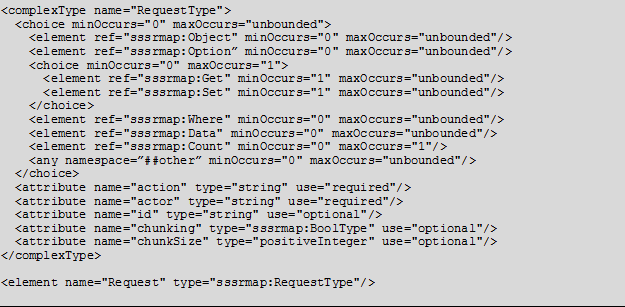
The Object Element
The Object element is used in an object-oriented request to specify the object receiving the action. It is possible to have multiple Object elements in a request if an implementation supports multi-object queries.
The object class name is specified as text content. All attributes are optional.
- join – the type of join to be performed with the preceding object
- A join attribute of “Inner” specifies an inner join. This is the default.
- A join attribute of “FullOuter” specifies a full outer join.
- A join attribute of “LeftOuter” specifies a left outer join.
- A join attribute of “RightOuter” specifies a right outer join.
- A join attribute of “Cross” specifies a cross join.
- A join attribute of “Union” specifies a union join.

The Get Element
The Get element is used to indicate the data fields to be returned in a query. Get is typically used within requests with action=”query”. Multiple Get elements cause the fields to be returned in the order specified. If no Get elements are specified, the query will return a default set of fields.
Only a name attribute is required. All other attributes are optional.
- name – the name of the data field to be returned. This MUST be of the form of a “Modified XPATH expression” as described in a later section.
- op – the operator to be used to aggregate or perform an operation on the returned values.
- An op attribute of “Sort” specifies an ascending sort operation
- An op attribute of “Tros” specifies a descending sort operation
- An op attribute of “Sum” returns the sum (only valid for numeric values)
- An op attribute of “Max” returns the maximum value
- An op attribute of “Min” returns the minimum value
- An op attribute of “Count” returns the number of values
- An op attribute of “Average” returns the average of the values
- An op attribute of “GroupBy” signifies that aggregates are grouped by this field
- object -- specifies the object for which you want the named attribute in a multi-object query.
- units – the units in which to return the value (if applicable)
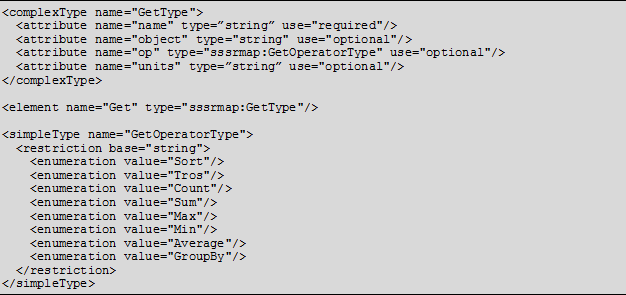
The Set Element
The Set element is used to specify the object data fields to be assigned values. Set is typically used within requests with action=”Create” or action=”Modify”. The use of Get or Set elements within a request are mutually exclusive.
The assignment value (to which the field is being changed) is specified as the text content. A Set element without a value may be used as an assertion flag. Only the name attribute is required. All other attributes are optional.
- name – the name of the field being assigned a value. This MUST be of the form of a “Modified XPATH expression” as described in a later section.
- op – the operator to be used in assigning a new value to the name. If an op attribute is not specified and a value is specified, the specified value will be assigned to the named field (“assign”).
- An op attribute of “Assign” assigns value to the named field
- An op attribute of “Inc” increments the named field by the value
- An op attribute of “Dec” decrements the named field by the value
- units – the units corresponding to the value being set
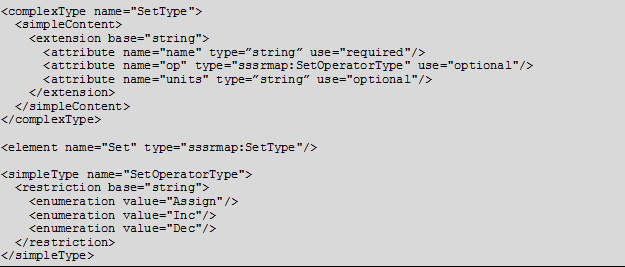
The Where Element
A Request element may contain one or more Where elements that specify the search conditions for which objects the action is to be performed on.
The condition value (against which the field is tested) is specified as the text content. A Where element without a value may be used as a truth test. Only the name attribute is required. All other attributes are optional.
- name – the name of the data field to be tested. This MUST be of the form of a “Modified XPATH expression” as described in a later section.
- op – the operator to be used to test the name against the value. If an op attribute is not specified and a value is specified, the field will be tested whether it is equal to the value (“EQ”).
- An op attribute of “EQ” specifies an equality comparison
- An op attribute of “LT” specifies a “less than” comparison
- An op attribute of “GT” specifies a “greater than” comparison
- An op attribute of “LE” specifies a “less than or equal to” test
- An op attribute of “GE” specifies a “greater than or equal to” test
- An op attribute of “NE” specifies a “not equal to” test
- An op attribute of “Match” specifies a regular expression matching comparison
- conj – indicates whether this test is to be anded or ored with the immediately preceding where condition
- A conj attribute of “And” specifies an “and” conjunction
- A conj attribute of “Or” specifies an “or” condition
- A conj attribute of “AndNot” specifies an “and not” conjunction
- A conj attribute of “OrNot” specifies an “or not” condition
- group – indicates an increase or decrease of parentheses grouping depth
- A positive number indicates the number of left parentheses to precede the condition, i.e. group=”2” represents “((condition”.
- A negative number indicates the number of right parentheses to follow the condition, i.e. group=”-2” represents “condition))”.
- object – specifies the object for the first operand in a multi-object query.
- subject– specifies the object for the second operand in a multi-object query.
- units – indicates the units to be used in the value comparison
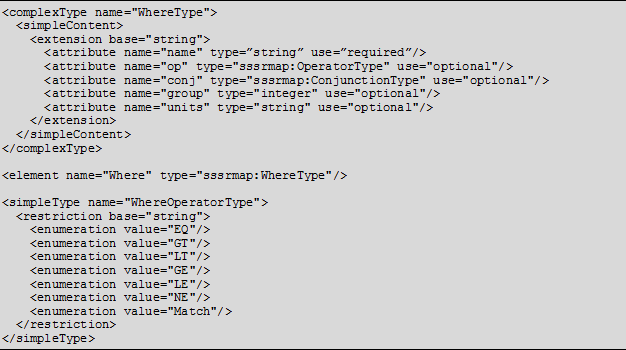
The Option Element
The Option element is used to indicate processing options for the command. An option might be used to indicate that command usage or special formatting is desired, or that the command is to be invoked with particular options.
The option value is specified as the text content. An Option element without a value may be used as an assertion flag. Only the name attribute is required. All other attributes are optional.
- name – the name of the field being assigned a value
- op – the operator to be used to disassert the option
- An op attribute of “Not” specifies that the option is not asserted
- conj -- indicates whether this test is to be anded or ored with the immediately preceding where condition
- A conj attribute of “And” specifies an “and” conjunction
- A conj attribute of “Or” specifies an “or” condition
- A conj attribute of “AndNot” specifies an “and not” conjunction
- A conj attribute of “OrNot” specifies an “or not” condition
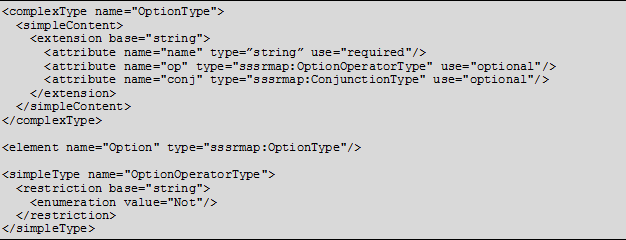
The Data Element
A Request or Response element may have one or more Data elements that allow the supplying of context-specific data. A request might pass in a structured object via a Data element to be acted upon. Typically a query will result in a response with the data encapsulated within a Data element.
The following attributes are optional:
- name – object name describing the contents of the data
- type – describing the form in which the data is represented
- A type attribute of “XML” indicates the data has internal xml structure and can be recursively parsed by an XML parser
- A type attribute of “Binary” indicates the data is an opaque dataset consisting of binary data
- A type attribute of “String” indicates the data is an ASCII string
- A type attribute of “Int” indicates the data is an integer
- A type attribute of “Text” indicates the data is in formatted human-readable text
- A type attribute of “HTML” indicates the data is represented in HTML

The File Element
A Request or Response element may have one or more File elements of type String that allow the inclusion of files. The files may be either text or binary and may be referenced by objects inside the Data element. A file may be compressed using the gzip algorithm [ZIP]. A binary file or a compressed file must be base64 encoded as defined in XML Digital Signatures (“http://www.w3.org/2000/09/xmldsig#base64”). Metadata describing the modes and properties of the resulting file are passed as parameters. The text or base64 encoded file data forms the string content of the File element.
The following attributes are optional:
- id – specifies an identifier that allows the file to be referenced from within another object. If more than one File elements are specified, this attribute is REQUIRED in each of them.
- name – specifies the name to give the file upon creation on the target system. This can be an absolute or relative pathname (relative to the InitialWorkingDirectory).
- owner – indicates what owner the file should be changed to. By default it will be changed to the UserId that the authenticated actor maps to on the target system. Note that this function should succeed only if the requestor has the privileges to do so (i.e. authenticated as root).
- group – indicates what group the file should be changed to. By default it will be set to the primary groupid of the UserId that the authenticated actor maps to on the target system. Note that this function should succeed only if the requestor has the proper privileges.
- mode – indicates the permissions the file should possess. By default it will be set according to the default umask for the UserId that the authenticated actor maps to on the target system. Note that this function should not set permissions for the file that exceed the privileges for the actor. These permissions can be specified using either an octal number or symbolic operations (as accepted by the GNU chmod(1) command).
- compressed – indicates whether the file has been compressed
- A compressed attribute of “True” indicates the file has been compressed.
- A compressed attribute of “False” indicates the file has not been compressed. This is the default.
- encoded – indicates whether the file has been base64 encoded
- An encoded attribute of “True” indicates the file has been encoded.
- An encoded attribute of “False” indicates the file has not been encoded. This is the default.

25.0.0.1.3 The Count Element
A single Count element may be included within a Request or Response and is context-specific. This can be used to represent the number of objects acted upon or returned.

The Response Element
The Response element specifies an individual response. It MUST contain a Status element. It MAY also contain Count and any number of Data or File elements. If chunking has been requested and is supported by the server, a large response may be broken up into multiple chunks (each with their own envelope). The chunkNum attribute can be used to indicate which chunk the current one is. The chunkMax attribute can be used to determine when all the chunks have been received (all chunks have been received if chunkNum=chunkMax or chunkMax=0).
It MAY have any of the following attributes:
- id – uniquely maps the response to the corresponding request
- chunkNum – integer indicating the current chunk number [1 is implied when this attribute is missing or blank]
- chunkMax – integer indicating the number of chunks expected [-1 means unknown but more chunks to follow; 0 means unknown but this is the last chunk; 0 is implied if this attribute is missing or blank]
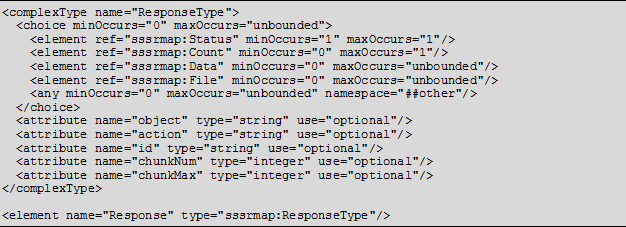
The Status Element
A Response element MUST contain a single Status element that indicates whether the reply represents a success, warning or failure. This element is composed of the child elements Value, Code and Message. Of these, Value and Code are required, and Message is optional.

The Value Element
The Value element is of type String and MUST have a value of “Success”, “Warning” or “Failure”.

The Code Element
A Response element must contain a single Code element that specifies the 3-digit status code for the response. Refer to the next section on Error Reporting for a description and listing of supported status codes.

The Message Element
A Response element may contain a single Message element that is context specific to the success or failure response. The message should be an error message if status is false. If present for a successful response, it may be used as a human readable message for a user interface.

3.3 Modified XPATH Expressions
The name attribute used within the Get, Set and Where Elements MUST have the form of a modified XPATH expression as defined in this section. Usually this will just be the simple name of the object property. Some complex objects, such as the SSS Job Object and the SSS Node Object, however, are represented in a structured way with nested elements. In order to define a consistent and flexible way to access and manipulate these objects as well as keeping the flat XML objects simple and straightforward, SSSRMAP specifies that a “Modified XPATH” syntax be used.
In essence, “Modified XPATH” is defined to be an XPATH [XPATH] expression with the exception that the “//” may be omitted from the beginning of the expression when a document search is desired. Thus, on the server side, a standard XPATH routine can be used by prepending “//” to any expression that does not begin with a “/”.
The response data should always include all of the structure of the queried object necessary to place the requested data in its proper context.
See the XPATH specification for a full description of XPATH. The XPath 1.0 Recommendation is http://www.w3.org/TR/1999/REC-xpath-19991116. The latest version of XPath 1.0 is available at http://www.w3.org/TR/xpath.
Sample Modified XPATH Expressions
Consider the following hypothetical object(s) (which might be returned within a Data element).
<Job>
<JobId>PBS.1234.0</JobId>
<Requested>
<Memory op=”GE”>512</Memory>
<Processors>2</Processors>
<WallDuration>P3600S</WallDuration>
</Requested>
<Utilized>
<Memory metric=”Average”>488</Memory>
<WallDuration>P1441S</WallDuration>
</Utilized>
</Job>
To get everything above for this job you would not need a Get element:
<Request action=”Query”>
<Object>Job</Object>
<Where name=”JobId”>PBS.1234.0</Where>
</Request>
If you used <Get name=”JobId”/> you would get back:
<Job>
<JobId>PBS.1234.0</JobId>
</Job>
If you used <Get name=”Memory”/> (or name=”/Job/*/Memory”) you would get:
<Job>
<Requested>
<Memory op=”GE”>512</Memory>
</Requested>
<Utilized>
<Memory metric=”Average”>488</Memory>
</Utilized>
</Job>
If you used <Get name=”Requested/Memory”/> (or name=”/Job/Requested/Memory”) you would get:
<Job>
<Requested>
<Memory op=”GE”>512</Memory>
</Requested>
</Job>
If you used <Get name=”Memory[@metric=’Average’]”/> (or name=”Memory[@metric]”) you would get:
<Job>
<Utilized>
<Memory metric=”Average”>488</Memory>
</Utilized>
</Job>
3.4 Examples
Sample Requests
Requesting a list of nodes with a certain configured memory threshold (batch format):
<Request action=”Query” id=”1”>
<Object>Node</Object>
<Get name=”Name” />
<Get name=”Configured/Memory” />
<Where name=”Configured/Memory” op=”GE” units=”MB”>512</Where>
</Request>
Activating a couple of users:
<Request action=”Modify”>
<Object>User</Object>
<Set name=”Active”>True</Set>
<Where name=”Name”>scott</Where>
<Where name=”Name” conj=”Or”/>brett</Where>
</Request>
Submitting a simple job:
<Request action=”Submit”>
<Object>Job</Object>
<Data>
<Job>
<User>xdp</User>
<Account>youraccount</Account>
<Command>myprogram</Command>
<InitialWorkingDirectory>/usr/home/scl/xdp</InitialWorkingDirectory>
<RequestedNodes>4</RequestedNodes>
<RequestedWCTime>100</RequestedWCTime>
</Job>
</Data>
</Request>
Sample Responses
A response to the available memory nodes query (batch format)
<Response id=”1”>
<Status>
<Value>Success</Value>
<Code>000</Code>
</Status>
<Count>2</Count>
<Data>
<Node>
<Name>fr01n01</Name>
<Configured>
<Memory>512</Memory>
</Configured>
</Node>
<Node>
<Name>fr12n04</Name>
<Configured>
<Memory>1024</Memory>
</Configured>
</Node>
</Data>
</Response>
Two users successfully activated
<Response>
<Status>
<Code>000</Code>
<Message>Two users were successfully modified</Message>
</Status>
<Count>2</Count>
</Response>
A failed job submission:
<Response>
<Status>
<Value>Failure</Value>
<Code>711</Code>
<Message>Invalid account specified. The job was not submitted.</Message>
</Status>
</Response>
4.0 Error Reporting
SSSRMAP requests will return a status and a 3-digit response code to signify success or failure conditions. When a request is successful, a corresponding response is returned with the status element set to Success and the code element set to “000”. When a request results in an error detected by the server, a response is returned with the status element set to Failure and a 3-digit error code in the code element. An optional human-readable message may also be include in a failure response providing context-specific detail about the failure. The default message language is US English. (The status flag makes it easy to signal success or failure and allows the receiving peer some freedom in the amount of parsing it wants to do on failure [BXXP]).
5.0 Acknowledgements
6.0 References
[BEEP] M. Rose, “The Blocks Extensible Exchange Protocol Core”, RFC 3080, March 2001.
[FED_XML] “U.S. Federal XML Guidelines”.
[HMAC] H. Krawczyk, M. Bellare, R. Canetti, “HMAC, Keyed-Hashing for Message Authentication”, RFC 2104, February 1997.
[HTTP] “Hypertext Transfer Protocol – HTTP/1.1”, RFC 2616, June 1999.
[RFC2119] S. Bradner, “Key Words for Use in RFCs to Indicate Requirement Levels”, RFC 2119, March 1997.
[RFC3117] M. Rose, “On the Design of Application Protocols”, Informational RFC 3117, November 2001.
[SHA-1] U.S. Department of Commerce/National Institute of Standards and Technology, “Secure Hash Standard”, FIPS PUB 180-1.
[SSS] “Scalable Systems Software”, http://www.scidac.org/ScalableSystems
[WIRE_PROTOCOL] S. Jackson, B. Bode, D. Jackson, K. Walker, “Systems Software Resource Management and Accounting Protocol (SSSRMAP) Wire Protocol“, SSS Resource Management and Accounting Documents, January 2004.
[XML] Bray, T., et al, “Extensible Markup Language (XML) 1.0 (Second Edition)”, 6 October 2000.
[XML_CONV] “I-X and <I-N-CA> XML Conventions”.
[XML_DSIG] D. Eastlake, J. Reagle Jr., D. Solo, “XML Signature Syntax and Processing”, W3C Recommendation, 12 February 2002.
[XML_ENC] T. Imamura, B. Dillaway, E. Smon, “XML Encryption Syntax and Processing”, W3C Candidate Recommendation, 4 March 2002.
[XML_SCHEMA] D. Beech, M. Maloney, N. Mendelshohn, “XML Schema Part 1: Structures Working Draft”, April 2000.
[XPath 1.0] J. Clark, S. DeRose, “XML Path Language (XPath) Version 1.0”, 16 November 1999.
[XRP] E. Brunner-Williams, A. Damaraju, N. Zhang, “Extensible Registry Protocol (XRP)”, Internet Draft, expired August 2001.
[ZIP] J. Gailly, M. Adler, “The gzip home page”, http://www.gzip.org/
















